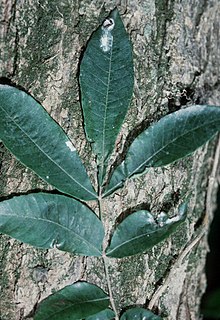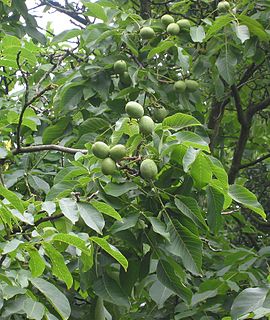
The Juglandaceae are a family, known as the walnut family, of trees, or sometimes shrubs, in the order Fagales. Various members of this family are native to the Americas, Eurasia, and Southeast Asia.
Members of the walnut family have large, aromatic leaves that are usually alternate, but opposite in Alfaroa and Oreomunnea. The leaves are pinnately compound or ternate, and usually 20–100 cm long.

Hickory is a type of tree, comprising the genus Carya. The genus includes 17 to 19 species. Five or six species are native to China, Indochina, and India (Assam), as many as 12 are native to the United States, four are found in Mexico, and two to four are from Canada. A number of hickory species are used for products like edible nuts or wood.

Carya ovata, the shagbark hickory, is a common hickory in the Eastern United States and southeast Canada. It is a large, deciduous tree, growing well over 100 ft (30 m) tall, and can live more than 350 years. The tallest measured shagbark, located in Savage Gulf, Tennessee, is over 150 ft (46 m) tall. Mature shagbarks are easy to recognize because, as their name implies, they have shaggy bark. This characteristic is, however, only found on mature trees; young specimens have smooth bark.
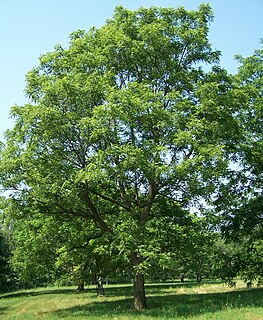
Juglandeae is a tribe of the Juglandoideae subfamily, in the Juglandaceae family.
Walnut tree species comprise the Juglans genus, which belong to the Juglandeae tribe.
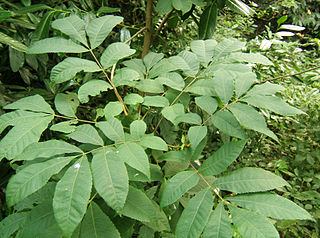
Carya cordiformis, the bitternut hickory, also called bitternut or swamp hickory, is a large pecan hickory with commercial stands located mostly north of the other pecan hickories. Bitternut hickory is cut and sold in mixture with the true hickories. It is the shortest-lived of the hickories, living to about 200 years.

Carya laciniosa, the shellbark hickory, in the Juglandaceae or walnut family is also called shagbark hickory, bigleaf shagbark hickory, kingnut, big, bottom, thick, or western shellbark, attesting to some of its characteristics. It is a slow-growing, long-lived tree, hard to transplant because of its long taproot, and subject to insect damage. The nuts, largest of all hickory nuts, are sweet and edible. Wildlife and people harvest most of them; those remaining produce seedling trees readily. The wood is hard, heavy, strong, and very flexible, making it a favored wood for tool handles. A specimen tree has been reported in Missouri with 117 cm (46 in) diameter at breast height, 36.9 m tall, and a spread of 22.6 m.

Carya tomentosa, is a tree in the Juglandaceae or walnut family. The most abundant of the hickories, common in the eastern half of the US, it is long lived, sometimes reaching the age of 500 years. A straight-growing hickory, a high percentage of its wood is used for products where strength, hardness, and flexibility are needed. The wood makes an excellent fuelwood, as well.

Carya myristiciformis, the nutmeg hickory, of the Juglandaceae or walnut family, also called swamp hickory or bitter water hickory, is found as small, possibly relict populations across the Southern United States and in northern Mexico on rich moist soils of higher bottom lands and stream banks. Little is known of the growth rate of nutmeg hickory. Logs and lumber are sold mixed with other hickories. The nuts are an oil-rich food for wildlife.
Oak-hickory forest is a type of North American forest ecosystem, and an ecoregion of the Temperate broadleaf and mixed forests Biome.
A hican is a tree resulting from a cross between a pecan and some other type of hickory - or the nut from such a hybrid tree.
'Burton' is a cultivar of hican, a cross between hickory and pecan, species of the genus Carya. The Burton is an edible nut of the hicans; it is considered a shagbark. Hicans can be both edible or inedible, if the nut is larger but the tree produces far less than a shagbark they are considered shellbarks. A seedling from 'Burton' is commonly called a 'Dooley Burton' it is also an edible hican nut. Burton and Dooley Burton nuts have a unique, yet very pleasing hickory flavor indicative to hickory trees. Of the two Dooley Burton seedlings produce a more noticeable hickory-flavored nut. Hickory-pecan hybrids are often unproductive.
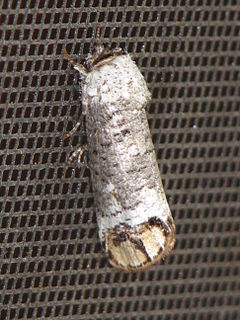
Cossula magnifica, the pecan carpenterworm moth, is a moth of the family Cossidae found in the southeastern parts of United States, from North Carolina south to Florida, and west to Mississippi and Texas.

Azaleatin is a chemical compound. It is an O-methylated flavonol, a type of flavonoid. It was first isolated from the flowers of Rhododendron mucronatum in 1956 and has since been recorded in forty-four other Rhododendron species, in Plumbago capensis, in Ceratostigma willmottiana and in Carya pecan. It has been also been found in the leaves of Eucryphia.

Datana integerrima, the walnut caterpillar moth, is a moth of the family Notodontidae. It is found in eastern North America, from Ontario, through most of the Eastern States west to Minnesota and south to northern Mexico.

Jugandoideae is a subfamily of the walnut family Juglandaceae.
The pecan weevil, Curculio caryae is an obligate feeder on the nuts of North American hickories and pecans, most widely recognized as an economically important pest of the pecan, Carya illinoinensis. It has also been observed to infest one Juglans species, the Persian walnut, Juglans regia.

Gretchena bolliana, the pecan bud moth or gray-flanked gretchena moth, is a moth of the Tortricidae family. It is found in the United States from South Carolina to Florida and west to Texas, Arizona and New Mexico.
Argyrotaenia juglandana, the hickory leafroller moth, is a species of moth of the Tortricidae family. It is found in North America, where it has been recorded from Alabama, Arkansas, Florida, Illinois, Indiana, Kentucky, Louisiana, Maryland, Mississippi, Missouri, New Hampshire, New York, North Carolina, Ohio, Ontario, Pennsylvania, Quebec, Tennessee, Texas, West Virginia and Wisconsin. The habitat consists of deciduous woodlands and parks where hickory grows.

